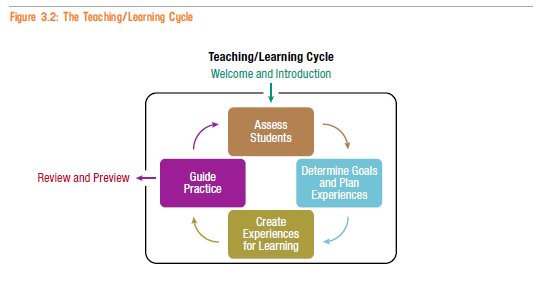In PSIA-AASI’s new multi-discipline teaching manual, Teaching Snowsports, a framework called the Learning Connection organizes information into 3 domains: people skills, teaching skills, and technical skills. The extensive material found in the teaching skills section is divided into 2 chapters: Learning (theory and concepts) and Teaching (process and application). Within the Teaching chapter lies the Teaching/Learning Cycle, which is the topic of this article.
Over the years, the Teaching Cycle has been revised many times to accentuate evolving beliefs about teaching snowsports. The current title change to Teaching/Learning Cycle reflects the philosophy of the Learning Partnership, which is characterized by the shared responsibility and combined effort of the instructor and student. It is a collaborative relationship, filled with active participation by the student toward achieving outcomes that are agreed upon for the lesson. Contemporary learning theory provides the basis for the Teaching/Learning Cycle, and supports characteristics of effective learning: collaboration, linking new learning to known experiences, connecting understanding to feelings and sensations, and structured reflection. These characteristics are woven into the phases of the Teaching/Learning Cycle.
The Teaching/Learning Cycle has also changed to provide a simpler representation of the essential interactions between instructors and students. It is a structured yet adaptable process to manage the snowsports learning experience. With this methodology, instructors constantly assess personal and performance needs, adjust plans and goals, create purposeful experiences, and guide practice. They check for understanding every step of the way.
To take a closer look at the content and depth of the Teaching/Learning Cycle, let’s examine the phase, Create Experiences for Learning. Like all the phases, it has a list of objectives. The nature of the objectives reflects a departure from the message of the past heading: Present and Share Information. It contains more elements of experience- and collaborative-based learning.
Create Experiences for Learning
- Organize students and the lesson environment.
- Choose appropriate terrain and snow conditions.
- Use experiences to target change in performance and understanding.
- Engage students in a process of reflection.
- Introduce new experiences and information based on student readiness.
- Provide descriptive instruction that’s easy to understand.
- Promote group engagement, interaction, and support.
In Teaching Snowsports, each phase is color-coded and has pages of support material that provide direction on how to achieve the objectives. For example, under the objective, Use Experiences to Target Change in Performance and Understanding, there are the following subheadings. Each subheading has further information about best practices that bring to life essential interactions between teachers and students.
- Use different strategies to introduce new experiences
- Highlight what before how
- Target feelings and sensations
- Confirm students’ understanding of feelings and sensations
- Always return the focus to the desired outcomes
- Provide outcome-based feedback
Think of the phases as being made up of different tiers of information into which instructors can delve as deeply as they choose. For new instructors, the phases provide guiding steps and promote an orderly flow to the lesson. Experienced instructors can read their students and identify when and how to adjust a lesson. The process still flows, but the instructor determines if and when phases need to be revisited as they continually check for understanding and work towards the mutual goals of the lesson.
The Teaching/Learning Cycle provides an in-depth resource for teaching snowsports, but it is only part of the wealth of information contained between the covers of this book-sized manual. Other chapters besides those related to the Learning Connection are:
- Creative Learning Environments
- Managing Risk in the Mountain Environment
- Sports Psychology – Mental Skills for Performance
- Physical Fitness and Conditioning
- Service Relationships
- Professional Development
Teaching Snowsports is designed to be a resource you can reference throughout your career. Turning the pages, you’ll find tactics for creating open and collaborative relationships with your students, strategies for teaching, and ways to address technique through a lesson filled with purposeful experiences.



